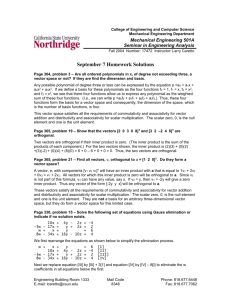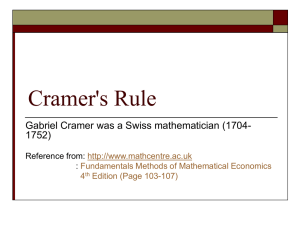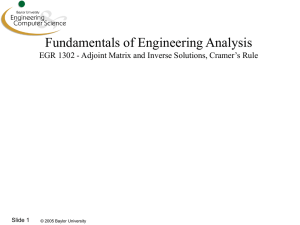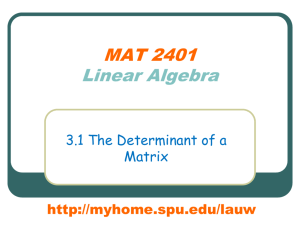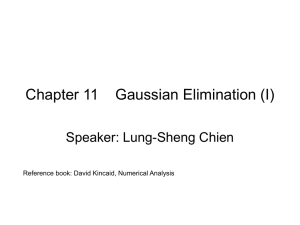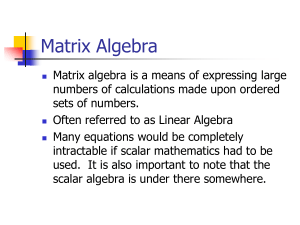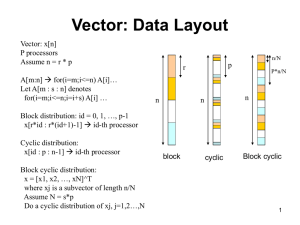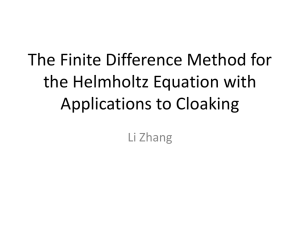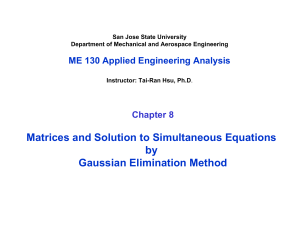P{A A, A A, A B }
advertisement
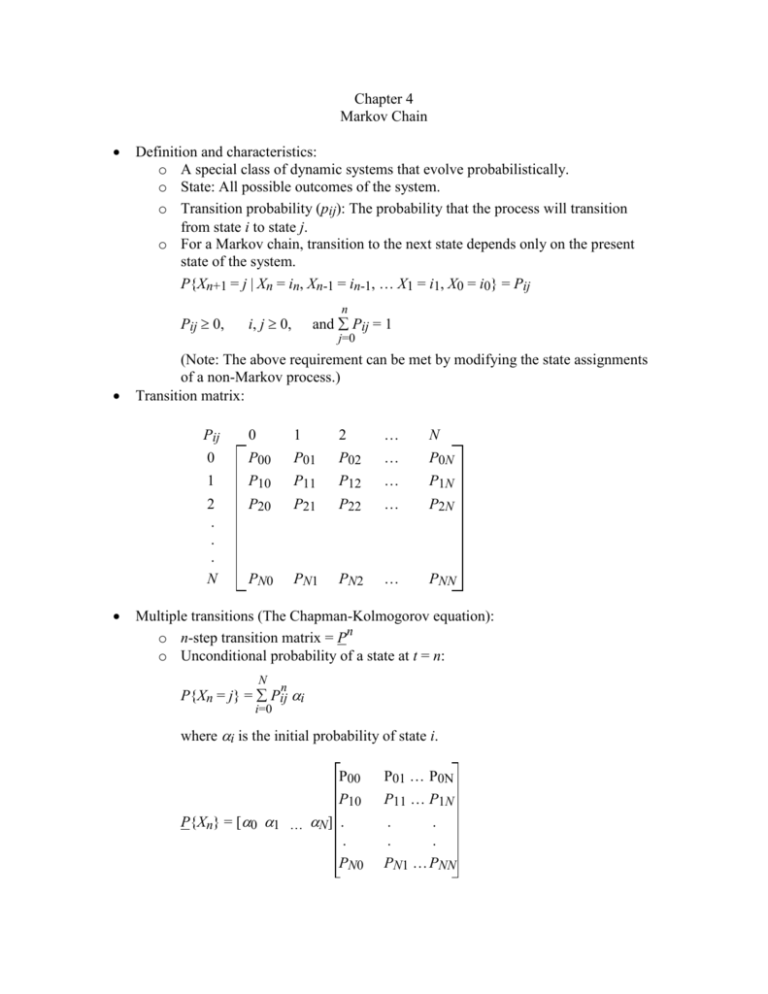
Chapter 4
Markov Chain
Definition and characteristics:
o A special class of dynamic systems that evolve probabilistically.
o State: All possible outcomes of the system.
o Transition probability (pij): The probability that the process will transition
from state i to state j.
o For a Markov chain, transition to the next state depends only on the present
state of the system.
P{Xn+1 = j | Xn = in, Xn-1 = in-1, … X1 = i1, X0 = i0} = Pij
Pij 0,
n
i, j 0,
and Pij = 1
j=0
(Note: The above requirement can be met by modifying the state assignments
of a non-Markov process.)
Transition matrix:
Pij
0
1
2
…
N
0
P00
P01
P02
…
P0N
1
P10
P11
P12
…
P1N
2
.
.
.
N
P20
P21
P22
…
P2N
PN0
PN1
PN2
…
PNN
Multiple transitions (The Chapman-Kolmogorov equation):
o n-step transition matrix = Pn
o Unconditional probability of a state at t = n:
N
n
P{Xn = j} = Pij i
i=0
where i is the initial probability of state i.
P10
P01 … P0N
P11 … P1N
P{Xn} = [0 1 … N] .
.
PN0
.
.
.
.
PN1 … PNN
P00
Markov chain example
Question: The following transition matrix describes the grade change of a college
student from one year to another. Find the probability that
a) an “A” incoming freshman would become a “B” student after the first year;
b) an “A” incoming freshman would become a “B” student after the second year;
c) an “A” incoming freshman would become a “B” student after the third year;
d) an “A” incoming freshman would graduate with an “A” average;
e) a “B” incoming freshman would graduate with a “C” average.
f) If the grade distribution of incoming freshman are:
A – 10%
B – 40%
C – 30%
D – 20%
F – 0%
Find the grade distribution of the graduates.
A
B
C
D
F
A
0.5
0.25
0
0
0
B
0.5
0.5
0.25
0
0
C
0
0.25
0.5
0.25
0
D
0
0
0.25
0.5
0.5
F
0
0
0
0.25
0.5
a) P{A B} = 0.5
b) P{A B, B B}
= 0.5 0.5
=
0.25
P{A A, A B}
= 0.5 0.5
=
0.25
0.50
c) P{A B, B B , B B} = 0.5 0.5 0.5
+
=
0.125
P{A B, B A , A B} = 0.5 0.25 0.5
=
0.0625
P{A B, B C , C B} = 0.5 0.25 0.25
=
0.03125
P{A A, A B , B B} = 0.5 0.5 0.5
=
0.125
P{A A, A A, A B } = 0.5 0.5 0.5
=
0.125
0.46875
d) 0.273
e) 0.25
f)
( .1 .4 .3 .2 0 ) A
4
0.154 0.295 0.256 0.205 0.09
o Problems: 4.2, 4.3, 4.7, 4.8
+
Classification of states:
n
o Accessible (i j): Pij > 0 for some n 0.
o Communication (i j): i j and j i
ii
ijji
i k and j k i j
o Class: States that communicate are said to be in the same class. Any two
classes are either identical or disjoint (no overlap).
o Irreducible Markov chain: All states communicate with each other (one class,
no transient states).
o Absorbing state: Pii = 1
o Recurrent state: A state that will be revisited infinitely often.
o Transient state: Each time the process departs from the state there will be a
positive probability that the process will never again reenter the state. As a
result, the process will reenter a transient state a limited number of times.
o Properties of recurrent states:
A finite-state Markov chain must have at least one recurrent state.
Any state that communicates with a recurrent state must also be
recurrent.
All states in a irreducible finite-state Markov chain are recurrent.
o Problems: 4.14
Limiting probability (long-run proportion, stationary probability)
o Periodic state: A state is said to be periodic with a period d when the
probability of returning to itself in n steps is 0 unless n is an integer multiple
of d.
o An aperiodic state has a period of 1 – it can return to itself in any number of
steps.
o Positive recurrent state: If the expected time for a recurrent state to return to
itself is finite, then it is a positive recurrent state.
o Positive recurrence is a class property.
o In Markov chains with a finite number of states, all recurrent states are
positive recurrent.
o Ergodic states: Positive recurrent, aperiodic states
o The limiting probability of Ergodic Markov chains can be computed using the
following simple procedures:
Lim Pn =
n
is the unique, nonnegative solution of the following equations:
N
j = i Pij
i=0
N
i = 1
j=0
j0
o If the limiting probabilities of a (3 X 3) Markov chain is:
a11
P a 21
a31
a13
a 23
a33
a12
a 22
a32
a11
n
lim P lim a 21
n
n
a31
a11
lim a 21
n
a13
a12
a 22
a 23
a12
a 22
a32
a13
1 2 3
a 23 1 2 3
1 2 3
a33
n
n
a13
a11
a 23 lim a 21
n
a13
a33
1 2 3 a11
1 2 3 a 21
1 2 3 a31
a12
a 22
a32
a13
a 23
a33
a13
a 23
a33
a12
a 22
a 23
n 1
a11
a 21
a32
1 2 3 1 2 3 a11
1 2 3 1 2 3 a 21
1 2 3 1 2 3 a31
1 2 3 a11 1 a 21 2 a31 3
1 2 3 a11 1 a 21 2 a31 3
1 2 3 a11 1 a 21 2 a31 3
a12
a 22
a32
n 1
a12
a 22
a32
n
a13 a11
a 23 a 21
a33 a31
a12
a 22
a32
a13
a 23
a33
a12 1 a 22 2 a32 3
a12 1 a 22 2 a32 3
a12 1 a 22 2 a32 3
a13 1 a 23 2 a33 3
a13 1 a 23 2 a33 3
a13 1 a 23 2 a33 3
1 a11 1 a 21 2 a31 3 a11 1 1 a 21 2 a31 3 0
2 a12 1 a 22 2 a32 3 a12 1 a 22 1 2 a32 3 0
3 a13 1 a 23 2 a33 3 a13 1 a 23 2 a33 1 3 0
a11 1
a12
a13
a 21
a22 1
a 23
a31 1 0
a32 2 0
a33 1 3 0
a13
a 23
a33
and
1 2 3 1
o This is a set of linear equations that can be solved with different techniques.
The new matrix equation set is not linearly independent. As a result, we can
obtain the limiting probabilities by solving two of the matrix equations and the
normalization equation (1 + 2 + 3 = 1).
o Solution techniques:
Numerical techniques
Analytical techniques
Symmetry
Special technique:
1. Let 1 = 1 (or any other convenient value)
2. Substitute 1 in to the equation set to solve for 2 and 3
3. Normalize the results:
1
1 2 3
2
1 2 3
3
1 2 3
1, final
2, final
3, final
o In general, the limiting probabilities of an N X N Markov chain can be
obtained from the following set of equations:
1 2 N 1
a11 1
a
21
.
.
a N 1
a12
.
.
.
.
.
.
.
.
.
.
aN 2
.
.
a22 1
1 0
a2 N 2 .
. .
.
.
. 0
a NN 1 N 0
a1N
o Again, because of the linear dependence of the matrix equation set, you need
to ignore one (your choice) of the matrix equations.
o With modern computing equipment the easiest way to calculate the limiting
probabilities is perhaps by calculating PN directly – Just keep rising the power
of P until convergence is observed.
o Problems: 4.18, 4.19, 4.21, 4.23, 4.29, 4.33, 4.35
o For general Markov chains use the Cayley-Hamilton theorem (EEE-241).
Meantime spent in transient states (Ex. 4.26 and 4.27, p. 227):
Sij = Expected time period spent in state j, given that the process starts in state i.
fij = the probability that the process makes a transition into state j, given that it
starts in state i.
PT = the transition matrix of transient states
S = (I – PT)-1
fij = (sij – ij) / sjj
Branching process:
o Mean number of offspring:
= j Pj
Pj = P{j new offspring}
j=0
o P{population dies out} = 0
0 = 1 for 1
For > 1, 0 = smallest positive root of the following equation
0 = 0 j pj
j=0
o Examples:
P0 = P1 = P2 = 1/3, Pj = 0 for j > 2
= 0*(1/3) + 1*(1/3) + 2*(1/3) = 1 0 = 1
P0 = 1/2, P1 = 1/4, P2 = 1/4, Pj = 0 for j > 2
= 0*(1/2) + 1*(1/4) + 2*(1/4) = 3/4 0 = 1
P0 = 0.1, P1 = 0.5, P2 = 0.4, Pj = 0 for j > 2
= 0*(0.1) + 1*(0.5) + 2*(0.4) = 1.3 (O.K.)
0 = 0.1 + 0.50 +0.402 402 – 50 + 1 = 0
0 = 0.25 or 1 0 = 0.25 (25% chance die out)
If P0 = 0, then the die out probability is always 0 (why???).
> 1 (why???)
One of the roots is always 0 (why???), which makes it the smallest
positive root, thus 0 = 0.
o Problem: 4.66
Time reversible Markov chain:
o Ergodic process: Ensemble average = time average
o The reverse process is also a Markov chain with transition probability:
Qij = (j / i) Pji
o If Qij = Pji then the Markov chain is called time reversible.
o Problem: 4.73
0
0.5
0.5
0.25
0.5
0.25
0.25
0.25
0.5
0 = 0.2, 1 = 2 = 0.4
0 P01 = 0.1
1 P12 = 0.1
2 P20 = 0.1
1 P10 = 0.1
2 P21 = 0.1
0 P02 = 0.1
